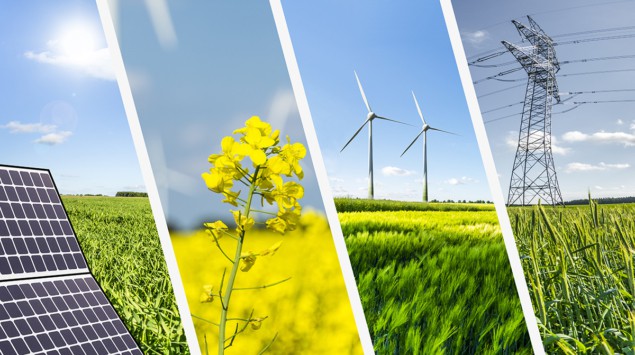100% renewables? No problems
21 Nov 2018 Dave Elliott
Australian academics Mark Diesendorf and Ben Elliston have challenged the views of fellow Australian academics Brook and Bradshaw and Heard et al., who criticized studies that claim it will be possible to supply 100% of global power (renewable electricity or “RElec”) or even all global energy needs from renewables. Instead, as I noted in my last post, Diesendorf and Elliston present a strong case for the alternative view — 100% is possible.
It’s hard-hitting stuff, with Diesendorf and Elliston also taking side-swipes at Trainer for dated data and challenging Smil’s view that the transition will be a slow process. They point to the possibility of mass production of low-cost renewable systems that are very different and faster to install than what went before. “Regions with insufficient local RE [renewable energy] resources will in future be able to import RE via transmission line and/or tanker carrying renewable fuels,” they add. A brave new green energy world, somewhat different from the brave new nuclear world that Brook and Bradshaw envisage and not totally incompatible with the “conserver society” that Trainer looks to.
Going on the offensive, Diesendorf and Elliston say: “contrary to unsupported claims by pro-nuclear RE critics that base-load power stations are essential, several of the simulation studies achieve reliability with zero or negligible base-load capacity. Furthermore, base-load power stations are poor partners for variable RElec, because of the former’s relative inflexibility in operation. Flexible, dispatchable power stations and storage technologies, together with demand response, are the appropriate partners.”
Going nuclear
That stands in sharp contrast to what you can sometimes hear from the nuclear lobby. For example, European nuclear lobby group Foratom says nuclear plants can be used to balance variable renewables. “To date, two-thirds of nuclear power plants in France have been operated routinely in flexible mode,” Foratom says. “This has demonstrated on a grand scale the ability of nuclear energy to balance the intermittency of variable renewables. Actually, nuclear energy appears as being the only large-scale, non-weather-dependent low-carbon technology that is capable of doing so.” Er, what about hydro, geothermal and biomass?READ MORE

However, Foratom does say that, while “technically, existing nuclear power plants and new designs can perform both frequency control and load-following operations,” actual practices “are heterogeneous in the EU”. The group says “the decision to perform load-following depends very much on how flexibility is valued by the national electricity market and on legal/regulatory constraints”. It believes the EU needs “a well-functioning electricity market recognizing the specificities of long-term investments in low-carbon energy sources and a functioning EU Emissions Trading Scheme delivering a long-term and predictable carbon price”. This, it claims, “would lead to a level playing field for all low-carbon energy sources in a market where subsidies were not needed. In such a market, a proper reward for flexibility would encourage nuclear power plant operators to operate in a flexible way.”
So nuclear power plant operators should be paid fully if they provide such services. Fair enough, but can nuclear plants really ramp up and down fast, often and safely to meet renewable shortfalls? The more usual case made for nuclear is that it offers baseload power — a case that, perversely, relies on its fixed output. The problem is that, as Diesendorf and Elliston note, in the new flexible supply and demand energy system context, the baseload concept is now seen by some as less relevant. Maybe that’s why the nuclear lobby is trying to talk up the alleged potential for flexibility. There are certainly issues related to grid frequency stability when variable renewables replace large conventional plants, and maybe the nuclear lobby would do better to stick to that, rather than trying for bulk supply balancing, but there are also some other solutions to the frequency support problem, e.g. the use of smart invertors to create “synthetic” inertia from battery stores and, for bulk supply, the conversion of surplus power from variable renewables to hydrogen and its use in gas turbines to make power when needed to balance renewable lulls. Those plants would also provide inertia and frequency stability.
All power to gas
In that context, it is interesting to see that the Power to Gas (P2G) idea is now being taken more seriously in the UK. The Institution of Mechanical Engineers has called on the government to support the growth of hydrogen and power-to-gas storage, in a report Energy from gas: taking a whole system approach. It worries about the sustainability of lithium ion batteries, whereas it says hydrogen “can be stored in the gas grid, pressurized canisters or salt caverns for “minutes, days, weeks or months, making it a more valuable medium than the battery”. P2G electrolysers can provide “sub-second response and continuous operating durations of days, weeks or months as required by electricity grid operators, making them a more valuable energy converter than a battery”. So, as its lead author said, with P2G “the UK gas grid has the potential to store excess electricity in the form of hydrogen for a greater amount of time than some other forms of energy storage, such as batteries”.READ MORE

There is now a £20 m hydrogen R&D fund that may help move things on, although much of that is focused on the use of hydrogen for heating, as a replacement for fossil gas — the other main option to its use for power grid balancing. Not everyone is fully onboard, however. A report from the Oxford Institute for Energy Studies Decarbonisation of heat and the role of ‘green gas’ in the UK says that, although green gas production and use may be viable for heating, it would be institutionally tricky, needing a large-scale state interventionist approach. Certainly, there would have to be regulatory controls over companies feeding hydrogen to the gas grid, but it’s not immediately obvious it would be that hard. But then this report seems to focus just on hydrogen produced by steam reformation of fossil gas, with carbon capture and storage (CCS) to make it carbon neutral. That would certainly require extensive central facilities. Producing hydrogen by electrolysis using surplus wind and solar power may not.
Costly issues
Cost is obviously the bottom line. On that, an Element Energy/E4tech study for the National Infrastructure Commission says all options for heat decarbonization –including hydrogen — are “significantly more costly” than staying with the status quo, although that, of course, will have hidden environmental and climate costs. However, the study also says that, of all the options, re-purposing the gas grid to deliver low-carbon hydrogen is the lowest cost option for heat decarbonizing, likely to cost about £100 bn less than electrifying the heating system by deployment of heat pumps. It does look like the electrification/heat pump route is dead, or less central now, and that hydrogen could be part of the way forward for heating, as well as playing a role in grid balancing.

There will of course be limits. Unless the amount of renewable capacity installed is very large, there may not be sufficient surplus to make hydrogen for both heating and balancing. But since most 100% renewables scenarios typically have enough renewables to meet demand most of the time, at times of low demand there should be plenty of surplus. Nevertheless, the use of green power surpluses (not continuous power) means that the expensive electrolysers would be left idle when there is no surplus, undermining their economics. An alternative route might be to use some of the surplus power to warm up large heat stores, adding to heat from other sources, and possibly from combined heat and power (CHP) plants, so as to meet heat demand peaks later on, via heat networks. That might be more economic than using hydrogen from P2G for heating via the gas mains. But it depends on whether P2G electrolysis turns out to be viable on a significant scale. In my next post I will look at the latest P2G studies — it is actually looking quite good. Either way, a balanced 100% renewable heat and power system does look increasingly viable.
21/11/2018 from physicsworld.com

Δεν υπάρχουν σχόλια:
Δημοσίευση σχολίου